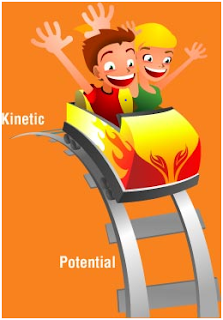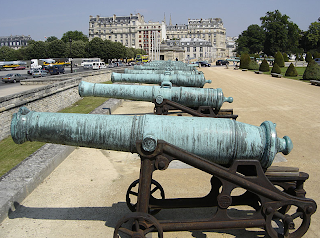The roller coaster is driven almost entirely by inertial, gravitational and centripetal forces.
The train is moved by gravity and momentum. When a coaster has reached the highest point along its course, normally a tall hill at the beginning of the circuit, gravity is what provides the force that controls the speed of the ride. Inertia is the reluctance of a body ( for example, a coaster train) to change its direction of motion. A coaster train that is accelerating down a steep hill will resist the change in direction and head up the next hill.
But before the train can gain momentum and take advantage of gravitational forces, it needs an initial push to get up the hill.
A chain loop can be used to move the train up. This can consist of a gear at the bottom attached to a motor that moves the roller coaster up.
A catapult launch can build up a great amount of kinetic energy over a short time.
The potential energy the roller coaster builds going up the hill is released as kinetic energy, the energy of motion that takes the coaster down the hill.
The coaster tracksare important in channeling the force. They control the way the coaster cars fall. If the tracks slope down, gravity pulls the front of the car toward the ground. The coaster therefore accelerates. If the tracks tilt up gravity applies a downward force on the back of the coaster. The coaster decelerates.
An object in motion tends to stay in motion (Newton's first law of motion.) The roller coaster car will maintain a forward velocity even when it is moving up the track. This movement is opposite the force of gravity. When the coaster ascends one of the smaller hills that follows the initial lift hill, its kinetic energy changes back to potential energy. It is back at the top. The course of the track is constantly converting energy from kinetic to potential vice versa again.
In most roller coasters, the hills decrease in height as they progress along the track. Thsi happens because the total energy reservoir built up in the lift hill is gradually lost to friction.There is friction between the train and the track and between the train and the air. When the train reaches the end of the track the energy reservoir is almost completely empty.
Roller coasters have brake systems. Those brake systems however, are not situated on the coaster itself, but on the tracks. There are a series of clamps built into the track of the train. There is a central computer system which operates the hydraulic system and closes the clamps for the train to stop.
To sum it all up , when a coaster is at the highest point of its track, there is a high potential energy This can be referd to as energy of position. When the coaster accelerates down the hill the potential energy changes into kinetic energy (or energy of motion). Each time the coaster goes up another hill, the kinetic energy turns into potential energy again. The cycle continues. Ideally, the total amount of energy would remain the same. However some is lost to friction between the wheels and the rails. There is wind drag along the train, and also friction applied by the brakes. Due to this energy loss, each successive hill along a coaster track needs to be smaller than the previous hill to allow the train to continue along the course.
Safety Features
By the nature of the laws of physics a roller coaster wants to fly off the track. Any accidents are prevented by the wheel design and the track.
The weight of the train is supported by running wheels (the largest wheels.)
On the sides of the coaster train guide wheels are arranged to provide stability during tight turns and to keep the coaster train from rubbing the structure of the ride.
Upstop wheels are smaller wheels. They are on the underside of the rails that keep the train locked to the track and allow the train more airtime because they eliminate the danger of the train leaving the track.
A rollback can occur when a coaster fails to crest a hill. Instead, it begins to move backward. Coaster trains are equipped with anti-rollbacks paired with the chain dogs. A rollback can be caused from too much gravity.


check out these websites for more information
http://tlc.howstuffworks.com/family/roller-coaster3.htm
http://www.essortment.com/hobbies/rollercoasters_sdzq.htm






